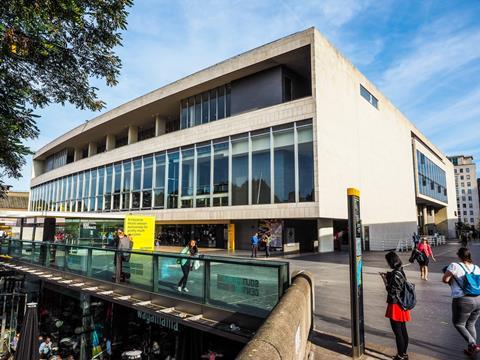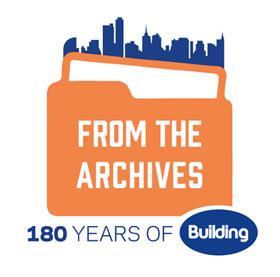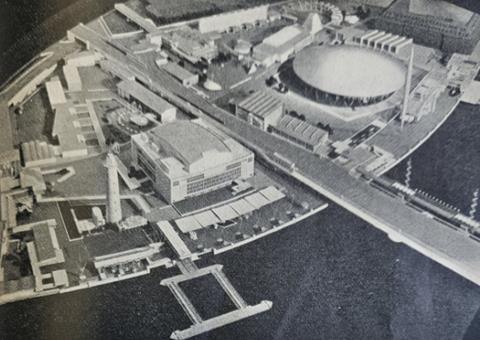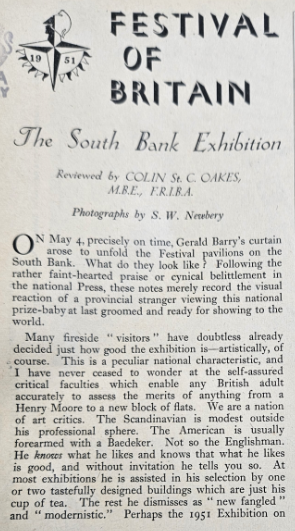A summer event showcasing the best of Britain’s modernist architecture helps London to embrace its postwar future

In the summer of 1951, Londoners still living among the ruins of wartime bombing were dazzled by the opening of the Festival of Britain on the capital’s South Bank. For a city in which food and other supplies had been rationed for more than a decade, the festival was a glimpse into the future and a symbol of postwar optimism.

More than eight million visitors, half of them from outside London, flocked to see the site’s daringly modern structures, from Skylon, a 90m-high tube of steel which appeared to float in the air, to the Royal Festival Hall, which still stands and is now grade I-listed.
Most impressive of all was the Dome of Discovery, an exhibition hall with a 111m-wide dome, at the time the largest in the world. It was controversially demolished after the summer and sold for scrap.
The event was also a moment for coming to terms with the imminent end of the British Empire, which had seen the independence of India, Pakistan and Sri Lanka four years earlier. Unlike the Great Exhbition of exactly a century before, the Festival of Britain focused almost entirely on domestic industry.
“Present circumstances and those of the Great Exhibition of 1851, which we are in part commemorating, have hardly anything in common,” The Builder said.
Below is the publication’s front page leader and a review of the festival in the month that it opened.

Leader, 18 May 1951
THE FESTIVAL
THERE can be no doubt that, once the original grandiose plans were abandoned, no better site than the South Bank could be found for the chief part of London’s contribution to the Festival of Britain. The big exhibitions of the past, like Wembley or the White City, though affording opportunities for planning on the grand scale, were far from ideal in situation, particularly the former, on account of distance from Central London, involving for most visitors the discomfort of travelling in crowded trains. The South Bank site is ideal for a small Metropolitan exhibition; it is the geographical centre of London, and only a few minutes by foot, bus or Tube from Charing Cross. Moreover, the area had long been “ripe for redevelopment,” and in the process of exhibition building London (following the example of Paris on similar occasions) has gained for herself some valuable permanent assets - including a fine new section of river embankment and a splendid Concert Hall.

The comparative smallness of the site (27 acres - more than enough, let it be said, to tire out the average visitor), has naturally precluded anything in the way of a grand formal layout, and the designers have gone all out for informality. Whether they have been completely successful in this is open to question. Notwithstanding the smallness of the exhibition it has been found possible to provide some fairly large open spaces - the largest of all, that between the Dome of Discovery and the Transport building, looks about the size of Trafalgar Square - but axiality is everywhere deliberately avoided. This straining after complete informality has produced in the subordinate parts of the exhibition a general effect of crowded disorder, and the eye longs for something regular to rest on. A small concession here and there to formality would, we believe, have knit the exhibition more together and made it visually more attractive.
Whatever may be the failings of its plan, there can be no doubt about the originality and attractiveness of the majority of its buildings, the charm and taste of its general furnishings, the gaiety of its awnings, trellises and screens. Even the Hungerford railway viaduct which divides the site into two has been made to look festive by the application of colour, decorative murals and other devices. Sculpture abounds on walls of buildings and in isolation; glass and metal, pools and fountains, greenery and colour gleam and sparkle about the two dominating set-pieces - the Dome of Discovery and the Concert Hall - the Dome a work of Wellsian fantasy of the future, particularly within, where complex staircases (fortunately an escalator as well) climb to remote galleries; the Concert Hall, of immense bulk, bare and severe without, impressive and richly functional within. This Concert Hall is undoubtedly a splendid addition to the cultural assets of London, a remarkable example of contemporary architecture, and a fine start to the permanent redevelopment of the South Side.

Architects, and particularly lovers of old London, in exploring the exhibition will not fail to note with appreciative eye the Rennie archway that still spans a small surviving section of the mostly obliterated Belvedere-road, and, built in under the embankment arch of the new Waterloo Bridge, two Doric columns and a section of the balustrade of the old one. From here they may quickly reach the nautical-looking promenades and embark via the Nelson or Rodney Pier on a steamer either to Battersea to sample the pleasures of the Festival Gardens and the Amusement Park or to Poplar to study the Exhibition of Live Architecture at Lansbury.

Though the South Bank Exhibition is bound to be the great centre of attraction, it must not be forgotten that what we are celebrating is a Festival of Britain and that throughout the country, in city, town and village, much is being done to show our overseas visitors the spirit and genius of our native land. Not only temporary but much lasting good may well come of these activities, not merely the permanent enhancement of local amenities but the improvement of friendly relations with the peoples of other lands. Present circumstances and those of the Great Exhibition of 1851, which we are in part commemorating, have hardly anything in common, yet the motto of that exhibition - “Agreement has bound together by peace things separated by locality” - is as apt to-day as it was then. If the Festival of Britain succeeds in strengthening the ties of the peace - and freedom - loving peoples of the world it will have been abundantly justified.
In the meantime, praise and thanks to the architectural and engineering professions and the building industry for their remarkable achievements on the South Bank.
Excerpts from a review of the festival by Colin St C. Oakes, 18 May 1951
ON May 4, precisely on time, Gerald Barry’s curtain arose to unfold the Festival pavilions on the South Bank. What do they look like? Following the rather faint-hearted praise or cynical belittlement in the national Press, these notes merely record the visual reaction of a provincial stranger viewing this national prize-baby at last groomed and ready for showing to the world.

Many fireside “visitors” have doubtless already decided just how good the exhibition is - artistically, of course. This is a peculiar national characteristic, and I have never ceased to wonder at the self-assured critical faculties which enable any British adult accurately to assess the merits of anything from a Henry Moore to a new block of flats. We are a nation of art critics. The Scandinavian is modest outside his professional sphere. The American is usually forearmed with a Baedeker. Not so the Englishman.. He knows what he likes and knows that what he likes is good, and without invitation he tells you so. At most exhibitions he is assisted in his selection by one or two tastefully designed buildings which are just his cup of tea. The rest he dismisses as “new fangled and “modernistic.” Perhaps the 1951 Exhibition on the South Bank will help these mass critics to appreciate the progress that has been made in architectural design and display since the Wembley Empire Exhibition; and possibly to re-educate them visually.
ESCAPE FROM STYLE
Here, on the South Bank, the architecture is free from fashionable intricacies, pedantry and style. The buildings show that we have architects and display designers in Britain as talented as any nation in the world, and these would be the first to offer thanks to the consultant engineers, Freeman Fox and Partners and R. T. James and Partners, who by common consent have done a magnificent job.
THE ADVENTURE OF THE DOME
Of all the exhibition structures on the South Bank, the Dome of Discovery has raised the most comments, complimentary and adverse. This is not surprising, however, in a nation composed almost entirely of art critics. First of all, with a 365-ft. span, it is the largest dome in the world, and, although it appears to squat modestly on the river front, the apex of this gleaming dome is nearly a hundred feet high. The dome construction is brave and adventurous. There is no monolithic flow from eaves to stanchion. Tubular steel latticed-struts end abruptly at the vast saucer’s rim, where they carry a continuous steel ring girder supporting the aluminium dome. At ground level the struts diminish to a 2-in. diameter steel pin, each with a capable stress of 31 tons. Internally, the construc- tion is less adventurous. The galleries are a separate structure, finished with precast concrete beams on a radial supporting core.
Within, the scale is colossal, and gives a sense of Wellsian unreality. This particularly noticeable at the main entrance where one descends six or seven steps and then, having cleared the gallery soffit, ascends into the vast arena.

A panorama of countless exhibits tell the story of British achievements in the field of discovery and exploration. Effigies of Newton, Faraday, Darwin, Cook and Livingstone are shown. Nuclear energy is displayed, and new forms of equipment for survey, research and disease. British explorers are seen mapping the globe. The circulation round these thousands of exhibits is a difficult task and one feels that the track plan could have been simplified by one continuous spiral ramp rising slowly on the same eccentric plan. The escalator could have conveyed visitors to the summit and all exhibits would be visible on the slow descent.

Another minor criticism is the congestion of exhibits at ground-floor level. These exhibits crowd the centre of the arena and give the commonplace atmosphere of a Continental covered market, particularly when viewed from the lower galleries. Here and there one has to switch-back from one gallery to another by rigid flights of stairs which are hard on the tired feet and spectacle-laden faculties of visitors. In the galleris the murals and exhibits are beautifully arranged, each representing a chapter in the story, and there is ample space for crowds to circulate. The massic walls are windowless and the reflected lights of the exhibits provide the artificial light for the whole interior of the great building. The building makes a splendid use of contemporary materials in structure and finishes; the flooring, colour and decorative treatment are most impressive. One feels that the mammoth drama within would have been less “Hollywood” had the ground-floor exhibits been less congested and the 74 in. lens telescope made even larger and centrally positioned as an altar for this vast Pantheon.
THE EXHIBITION SHOWPIECE
Outside, and blending magnificently with the Dome in scale and shape, is the Skylon. This is the showpiece of the whole exhibition. It is not visitable nor climbable (officially, at any rate) by the public; nor does it display exhibits. In design and construction, it is a delightful refinement from the very complicated to the very simple. The 250 ft. high body, parabolically tapering from a central 15 ft. to pointed ends, is suspended by three steel guys supported on three raking pylons taking the thrust. The Skylon is constructed in prefabricated steel angle-framed panels, welded and braced: the covering skin is of aluminium horizontal louvres which diffuse the internal tungsten lighting graded throughout its height. By day or night it floats 300 ft. into the sky in isolated fantasy. No matter from what angle it is viewed, it blends with its neighbours and background in unique simplicity.
More from the archives:
>> Nelson’s Column runs out of money, 1843-44
>> The clearance of London’s worst slum, 1843-46
>> The construction of the Palace of Westminster, 1847
>> Benjamin Disraeli’s proposal to hang architects, 1847
>> The Crystal Palace’s leaking roof, 1851
>> Cleaning up the Great Stink, 1858
>> Setbacks on the world’s first underground railway, 1860
>> The opening of Clifton Suspension Bridge, 1864
>> Replacing Old Smithfield Market, 1864-68
>> Alternative designs for Manchester Town Hall, 1868
>> The construction of the Forth Bridge, 1873-90
>> The demolition of Northumberland House, 1874
>> Dodging falling bricks at the Natural History Museum construction site, 1876
>> An alternative proposal for Tower Bridge, 1878
>> The Tay Bridge disaster, 1879
>> Building in Bombay, 1879 - 1892
>> Cologne Cathedral’s topping out ceremony, 1880
>> Britain’s dim view of the Eiffel Tower, 1886-89
>> First proposals for the Glasgow Subway, 1887
>> The construction of Westminster Cathedral, 1895-1902
>> Westminster’s unbuilt gothic skyscraper 1904
>> The great San Francisco earthquake, 1906
>> The construction of New York’s Woolworth Building, 1911-13
>> The First World War breaks out, 1914
>> The Great War drags on, 1915-16
>> London’s first air raids, 1918
>> The Chrysler Building and the Empire State Building, 1930
>> The Daily Express Building, 1932
>> Outbreak of the Second World War, 1939
>> Britain celebrates victory in Europe, 1945
>> How buildings were affected by the atomic bombs dropped on Japan, 1946



























No comments yet